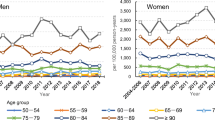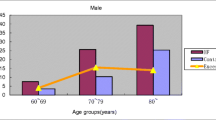Abstract
Summary
We investigated the secular trends of the incidence and hospitalization cost of hip fracture in Tangshan, China. The incidence of hip fracture and the hospitalization cost were both increasing during the observation period.
Introduction
The present study aimed to determine sex-, age-, and fracture type-specific incidence and annual changes in hip fractures in Tangshan, China, between 2007 and 2018.
Methods
We analyzed annual hip fracture incidence using urban hospital data during 2007–2018 and calculated incidence rate/100,000 person years in each age group and sex. We assessed annual changes in incidence among people aged >60 years using linear-by-linear association tests and evaluated hospitalization costs with the Kruskal–Wallis test.
Results
During the study period, we observed an increasing proportion of hip fractures in people >60 years old from 14.2 to 22.79%. Crude hip fracture incidence increased markedly from 140.87 to 306.56/100,000 in women (p < 0.01) and from 124.83 to 167.19/100,000 in men (p < 0.01) in the age group >60 years. Type-specific analysis indicated significantly increased trends in incidence of cervical and trochanteric fractures among women and cervical fracture among men (p < 0.01). In people aged 36–60 years, the trend of hip fracture increased significantly in both sexes. The total and cervical-to-trochanteric ratio in men increased, with significant upward trends (p < 0.01). The proportion of cervical fracture was higher than that for trochanteric fracture in women, with stable levels from 2007 to 2018. Hospitalization costs for cervical and trochanteric fractures increased by 51.91% and 53.20%, respectively, during 2011–2018.
Conclusion
Tangshan will have an increasing burden on health care resources attributable to a considerable rise in hip fracture incidence and the older population. Further investigation of risk factors and subsequent implementation of effective measures to prevent hip fracture are needed.



Similar content being viewed by others
Change history
30 November 2023
A Correction to this paper has been published: https://doi.org/10.1007/s00198-023-06987-1
References
Gu Y, Chen X, Wang Y et al (2020) Development of 3-mercaptopropyltrimethoxy-silane (MPTS)-modified bone marrow mononuclear cell membrane chromatography for screening anti-osteoporosis components from Scutellariae Radix. Acta Pharm Sin 10:1856–1865. https://doi.org/10.1016/j.apsb.2020.01.019
Akhtar MN, Gon S, Sen B et al (2020) Unveiling the metabolic mystery of fragility hip fracture in Indian patients: a histomorphometric and biochemical correlation. Indian J Orthop 54:297–306. https://doi.org/10.1007/s43465-020-00253-w
Hori K, Siu AM, Nguyen ET, Andrews SN, Choi SY, Ahn HJ, Nakasone CK, Lim SY (2020) Osteoporotic hip fracture mortality and associated factors in Hawai’i. Arch Osteoporos 1:183–192. https://doi.org/10.1007/s11657-020-00847-9
Veronese N, Maggi S (2018) Epidemiology and social costs of hip fracture. Injury 49:1458–1460. https://doi.org/10.1016/j.injury.2018.04.015
Yu A, Carballido-Gamio J, Wang L (2017) Spatial differences in the distribution of bone between femoral neck and trochanteric fractures. J Bone Miner Res 32:1672–1680. https://doi.org/10.1002/jbmr.3150
Mattisson L, Bojan A, Enocson A (2018) Epidemiology, treatment and mortality of trochanteric and subtrochanteric hip fractures: data from the Swedish fracture register. BMC Musculoskelet Disord 19:369–377. https://doi.org/10.1186/s12891-018-2276-3
Clark P, Lavielle P, Franco-Marina F, Ramírez E, Salmerón J, Kanis JA, Cummings SR (2005) Incidence rates and life-time risk of hip fractures in Mexicans over 50 years of age: a population-based. Osteoporos Int 16:2025–2030. https://doi.org/10.1007/s00198-005-1991-4
Icks A, Arend W, Becker C, Rapp K, Jungbluth P, Haastert B (2013) Incidence of hip fractures in Germany, 1995-2010. Arch Osteoporos 8:140–147. https://doi.org/10.1007/s11657-013-0140-5
Xia WB, He SL, Xu L, Liu AM, Jiang Y, Li M, Wang O, Xing XP, Sun Y, Cummings SR (2012) Rapidly increasing rates of hip fracture in Beijing, China. J Bone Miner Res 27:125–129. https://doi.org/10.1002/jbmr.519
Imai N, Endo N, Shobugawa Y, Ibuchi S, Suzuki H, Miyasaka D, Sakuma M (2017) A decrease in the number and incidence of osteoporotic hip fractures among elderly individuals in Niigata, Japan, from 2010 to 2015. J Bone Miner Metab 36:573–579. https://doi.org/10.1007/s00774-017-0863-2
Tan LT, Wong SJ, Kwek EB (2017) Inpatient cost for hip fracture patients managed with an orthogeriatric care model in Singapore. Singapore Med J Mar 58(3):139–144. https://doi.org/10.11622/smedj.2016065
Tian FM, Sun XX, Liu JY, Liu ZK, Liang CY, Zhang L (2017) Unparallel gender-specific changes in the incidence of hip fractures in Tangshan, China. Arch Osteoporos 12:18–25. https://doi.org/10.1007/s11657-017-0313-8
Michaelsson K, Weiderpass E, Farahmand B et al (1999) Differences in risk factor patterns between cervical and trochanteric hip fractures. Osteoporos Int 10:487–494. https://doi.org/10.1007/s001980050259
Gao J, Zheng Q, Lai FY, Gartner C, du P, Ren Y, Li X, Wang D, Mueller JF, Thai PK (2020) Using wastewater-based epidemiology to estimate consumption of alcohol and nicotine in major cities of China in 2014 and 2016. Environ Int 136:105492. https://doi.org/10.1016/j.envint.2020.105492
Berg KM, Kunins HV, Jackson JL et al (2007) Association between alcohol consumption and both osteoporotic fracture and bone density. Am J Med 121:406–418. https://doi.org/10.1016/j.amjmed
Mautalen CA, Vega EM, Einhorn TA (1996) Are the etiologies of cervical and trochanteric hip fractures different? Bone 18:133S- 137S. https://doi.org/10.1016/8756-3282(95)00490-4, 18, S133, S137
Jokinen H, Pulkkinen P, Korpelainen J, Heikkinen J, Keinänen-Kiukaanniemi S, Jämsä T, Korpelainen R (2020) Risk factors for cervical and trochanteric hip fractures in elderly women: a population-based 10-year follow-up study. Calcif Tissue Int 87:44–51. https://doi.org/10.1007/s00223-010-9382-z
Schott AM, Hans D, Duboeuf F, Dargent-Molina P, Hajri T, Bréart G, Meunier PJ, EPIDOS Study Group (2005) Quantitative ultrasound parameters as well as bone mineral density are better predictors of trochanteric than cervical hip fractures in elderly women. Results from the EPIDOS study Bone 37:858–863. https://doi.org/10.1016/j.bone.2005.06.024
Hernández JL, Olmos JM, Alonso MA, González-Fernández CR, Martínez J, Pajarón M, Llorca J, González-Macías J (2006) Trend in hip fracture epidemiology over a 14-year period in a Spanish population. Osteoporos Int 17:464–470. https://doi.org/10.1007/s00198-005-0008-7
Lim J (2020) Big data-driven determinants of length of stay for patients with hip fracture. Int J Environ Res Public Health 17:4949–4958. https://doi.org/10.3390/ijerph17144949
Caminiti C, Meschi T, Braglia L, Diodati F, Iezzi E, Marcomini B, Nouvenne A, Palermo E, Prati B, Schianchi T, Borghi L (2013) Reducing unnecessary hospital days to improve quality of care through physician accountability: a cluster randomised trial. BMC Health Serv Res 13:14–23. https://doi.org/10.1186/1472-6963-13-14
Aletto C, Aicale R, Pezzuti G, Bruno F, Maffulli N (2020) Impact of an orthogeriatrician on length of stay of elderly patient with hip fracture. Osteoporos Int 31:2161–2166. https://doi.org/10.1007/s00198-020-05510-0
Shojania KG, Duncan BW, McDonald KM et al (2002) Safe but sound: patient safety meets evidence-based medicine. JAMA 2884:508–513. https://doi.org/10.1001/jama.288.4.508
China Health Promotion Foundation (2008) White paper China osteoporosis a summary statement of China, Beijing
Si L, Winzenberg TM, Jiang Q et al (2015) Projection of osteoporosis-related fractures and costs in China: 2010-2050. Osteoporos Int 26:1929–1937. https://doi.org/10.1007/s00198-015-3093-2
Lin X, Xiong D, Peng YQ et al (2015) Epidemiology and management of osteoporosis in the People’s Republic of China: current perspectives. Clin Interv Aging 10:1017–1033. https://doi.org/10.2147/CIA.S54613
Wang YL, Cui HR, Zhang DY, Zhang P (2018) Hospitalization cost analysis on hip fracture in China: a multicentre study among 73 tertiary hospitals. BMJ Open 8:e019147. https://doi.org/10.1136/bmjopen-2017-019147
Acknowledgements
The authors express their special thanks to the participating hospitals in Tangshan, China, for allowing the collection of the research data, and Analisa Avila, ELS, of Liwen Bianji, Edanz Group China (www.liwenbianji.cn/ac), for editing the English text of a draft of this manuscript.
Funding
This work was supported by the Youth Talent Support Program of Hebei Province (JI-2016-10), One-Hundred Innovative Talents Support Foundation of Hebei Province (JJK-2019-14), and Natural Science Foundation of Hebei Province (H2019209550).
Author information
Authors and Affiliations
Corresponding authors
Ethics declarations
This study was approved by the local ethics committee at the North China University of Science and Technology.
Conflicts of interest
None.
Additional information
Publisher’s note
Springer Nature remains neutral with regard to jurisdictional claims in published maps and institutional affiliations.
The original version of this article has been revised to update affiliation 1.
Supplementary information

Supplementary Fig.1
The proportion of people aged > 60 in Tangshan, 2017-2018 (PNG 111 kb)
Rights and permissions
Springer Nature or its licensor (e.g. a society or other partner) holds exclusive rights to this article under a publishing agreement with the author(s) or other rightsholder(s); author self-archiving of the accepted manuscript version of this article is solely governed by the terms of such publishing agreement and applicable law.
About this article
Cite this article
Hou, Xl., Liu, Jy., Fan, Xh. et al. Secular trends of incidence and hospitalization cost of hip fracture in Tangshan, China. Osteoporos Int 33, 89–96 (2022). https://doi.org/10.1007/s00198-021-06050-x
Received:
Accepted:
Published:
Issue Date:
DOI: https://doi.org/10.1007/s00198-021-06050-x




